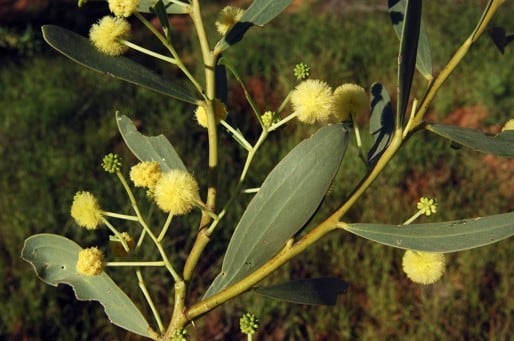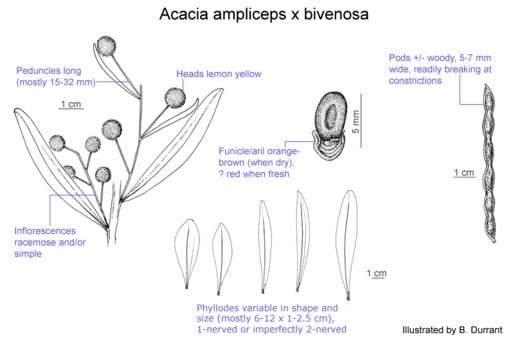Acacia ampliceps Maslin x Acacia bivenosa DC.
WATTLE
Acacias of Australia
Family
Fabaceae
Distribution
Scattered in W.A. from the Pilbara region N to the Dampier Pen. (N of Broome) and Fitzroy Crossing in the southern Kimberley region.
Description
Large, bushy, spreading, glabrous shrub 2–4 (–5) m high. Phyllodes spreading to ±erect, narrowly oblong-elliptic to oblanceolate, mostly ±straight, (5–) 6–12 cm long, 10–25 (–30) mm wide, dull green or subglaucous; midrib prominent, commonly less pronounced nerve parallel on adaxial side of midrib; gland 0–4 mm above pulvinus, a smaller gland often present at base of mucro. Inflorescences simple and/or racemose, racemes 1.5–4 (–10) cm long and often growing out; peduncles (9–) 15–32 mm long; heads lemon yellow, 20–35-flowered. Flowers 5-merous; calyx truncate to sinuate-toothed. Pods submoniliform, breaking readily into 1-seeded segments at the constrictions, 4–8 cm long, 5–7 mm wide, woody to coriaceous to crustaceous, yellowish brown. Seeds longitudinal, oblong, c. 5 mm long, dark brown; funicle/aril folded beneath the seed, orange-brown and waxy-looking when dry (?red when fresh).
Phenology
Flowers July–Aug.
Habitat
Grows along drainage lines or diffuse watercourses in sand or clay soils and appears to tolerate high levels of salinity.
Specimens
W.A.: Buckleys Bore, J.B.Martin 112 (PERTH); c. 3 km due E of Wickham, B.R.Maslin 8815 (PERTH); Ragged Hills Lead Mine, c. 130 km SE of Shay Gap, K.R.Newbey 10462 (MEL, PERTH).
Notes
Possibly has some horticultural potential, see B.R.Maslin et al., Wattles of the Pilbara CD-ROM (2010), for discussion. The phyllodes of this putative hybrid are not as severely attacked by leaf-eating insects as are those of A. ampliceps.
The hybrid status of this entity is based on field observations and morphology of specimens examined; it is often found in populations (commonly at a low frequency) with both presumed parents. Acacia ampliceps × bivenosa differs from both presumed parents in having lemon yellow heads; it is further distinguished from A. ampliceps in having shorter, straighter and often imperfectly 2-nerved phyllodes and from A. bivenosa by its longer phyllodes. In the Pilbara A. ampliceps also putatively hybridizes with A. sclerosperma subsp. sclerosperma (see A. ampliceps × sclerosperma); these hybrids are less common than A. ampliceps × bivenosa and are recognized by their narrower, consistently 1-nerved phyllodes and wider pods. Phyllodes of A. ampliceps × bivenosa may sometimes resemble those of A. bivenosa × sclerosperma subsp. sclerosperma.
FOA Reference
Flora of Australia Project
Author
B.R.Maslin
This identification key and fact sheets are available as a mobile application:
URL: https://apps.lucidcentral.org/wattle/
© Copyright 2018. All rights reserved.










